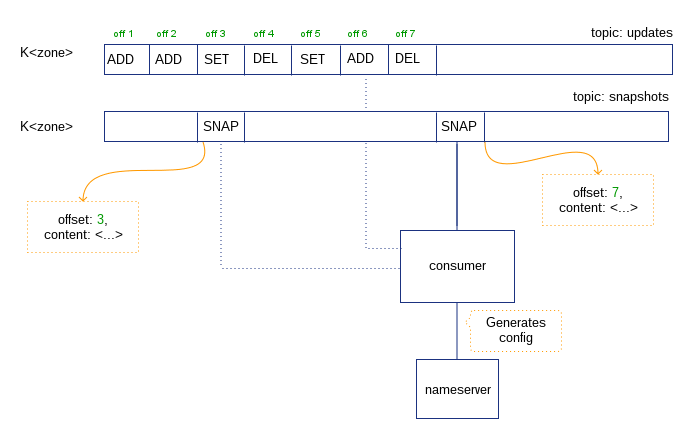I recently wrote about kafka log compaction and the use cases it allows. The article focused on simple key-value storage and did not address going beyond this. In practice, values associated with keys often need more than just bare values.
To see how log compaction can still be leveraged with more complex types, we will see how to approach maintaining the state of a list in kafka through the lens of a dynamic DNS setup.
DNS: the 30 second introduction
I assume my readers are familiar with the architecture of the Domain Name System (DNS). To summarize, DNS revolves around the notions of zones, separated by dots which follow a tree like hierachy starting at the right-most zone.

Each zone is responsible for maintaining a list of records. Records each have a type and an associated payload. Here’s a non-exhaustive list of record types:
Record Content
SOA Start of Authority. Provides zone details and timeouts.
NS Delegates zone to other nameservers.
A Maps a record to an IPv4 address.
AAAA Maps a record to an IPv6 address.
CNAME Aliases a record to another.
MX Mail server responsibility for a record.
SRV Arbitrary service responsibility for a record.
TXT Arbitrary text associated with record.
PTR Maps an IP record with a zone.
Given this hierarchy and properties, DNS can be abstracted to a hash table, keyed by zone. Value contents can be considered lists.
{
"exoscale.com": [
{record: "api", type: "A", content: "10.0.0.1"},
{record: "www", type: "A", content: "10.0.0.2"},
],
"google.com": [
{record: "www", type: "A", content: "10.1.0.1"}
]
}
In reality, zone contents are stored in zone files, whose content look roughly like this:
$TTL 86400
$ORIGIN example.com.
@ 1D IN SOA ns1.example.com. hostmaster.example.com. (
2015042301 ; serial
3H ; refresh
15 ; retry
1w ; expire
3h ; minimum
)
IN NS ns1.example.com. ; nameserver
IN NS ns2.example.com. ; nameserver
IN MX 10 mail.example.com. ; mail provider
; server host definitions
ns1 IN A 10.0.0.1
ns1 IN A 10.0.0.2
mail IN A 10.0.0.10
www IN A 10.0.0.10
api IN CNAME www
Based on our mock list content above, generating a correct DNS zone file is a simple process.
Dynamic DNS motivation
Dynamic DNS updates greatly help when doing any of the following:
- Automated zone synchronisation based on configuration management.
- Automated zone synchronisation based on IaaS content.
- Authorized and authenticated programmatic access to zone contents.
Most name servers support fast reloads and convergence of configuration, but still require generating zone files on the fly and reloading configuration. Kafka can be a very valid choice to maintain a stream of changes to zones.
Storing zone changes in Kafka
Updates to DNS zone usually trickle in as invidual record changes. An evident candidate for topic keys is the actual zone name. As far as changes are concerned it makes sense to store the individual record changes, not the whole zone on each change. Kafka payloads could thus be standard operations on lists:
Operation Effect
ADD Create a record
SET Update a record
DEL Delete a record
Each operation modifies the state of the list and reading from the head of a log for a particular key ensures that a correct, up to date version of a zone can be recreated:

Taking advantage of log compaction
While this is fully functional, the only correct compaction method for the above approach is time based, and requires reading from the head of the log. A simple way to address this issue is to create a second topic, meant to hold full zone snapshots, associated with the offset at which the snapshot was done. This allows to use log compaction on the snapshot topic.
With this approach, starting a consumer from scratch only requires two operations:
- Read the snapshot log from its head.
- Read the update log, only considering entries which are more recent than the associated snapshot time.

For this approach to work, a single property must remain true: snapshots emitted on the snapshot topic should be more frequent than the expiration on the update topic.
Similar use-cases
Beyond DNS, this approach is valid for all standard compound types and their operations:
- Stacks:
push,pop - Lists:
add,del,set - Maps:
set,unset - Sets:
add,del